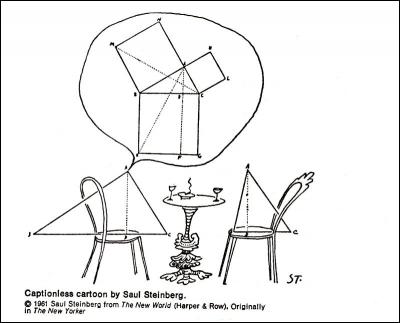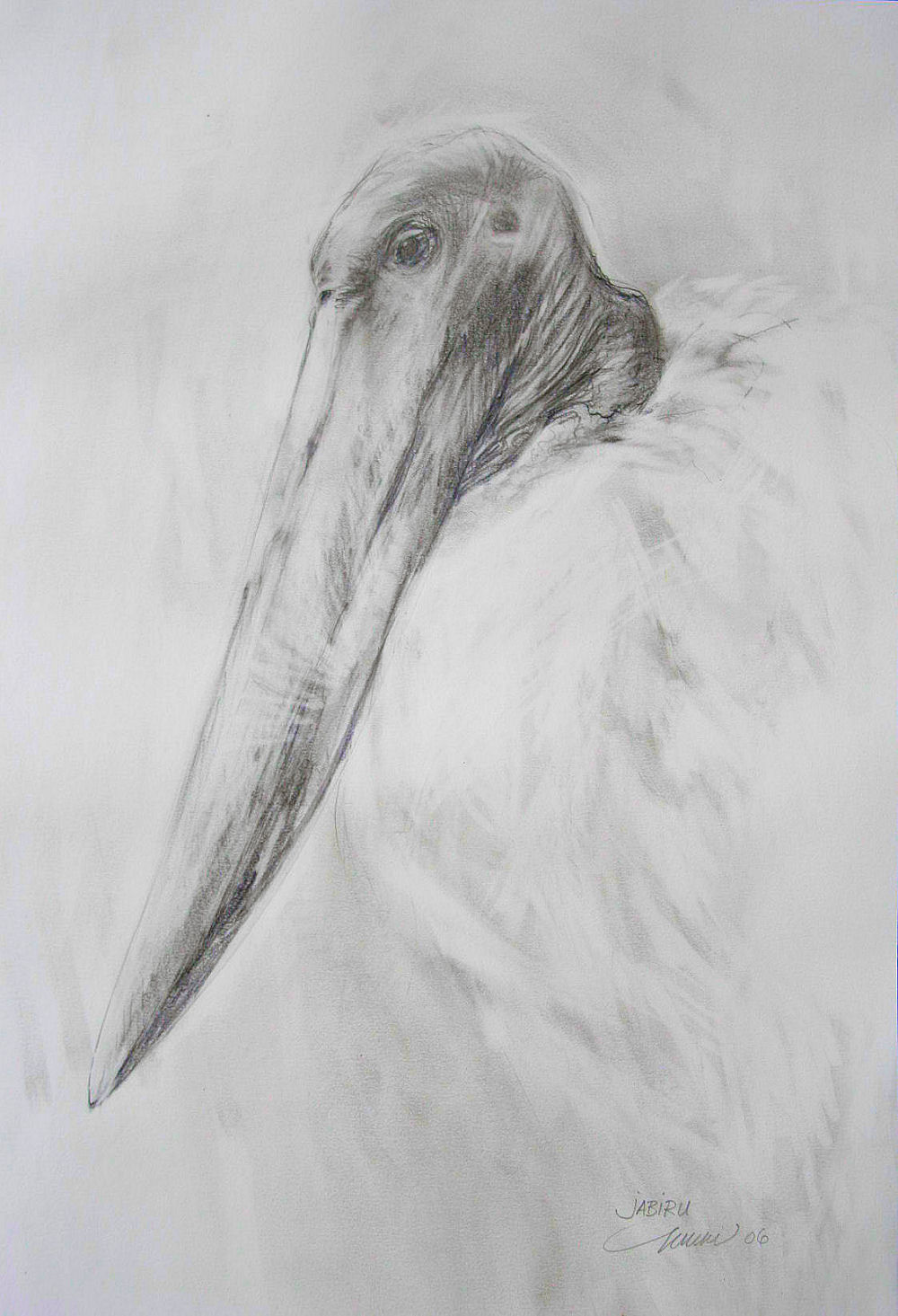inspiration
Next Entries »Out with the old, In with the old!
Tuesday, January 1st, 2008
 My studio is filled with all the things I love, including inspirational images and shelves of favorite objects. I still have Art supplies that I used in Grade 2, and hang on to various space-consuming materials like too much cardboard and a bulk of previous work. All this needs paring down at least once a year, and it’s always enlightening to sort through.
My studio is filled with all the things I love, including inspirational images and shelves of favorite objects. I still have Art supplies that I used in Grade 2, and hang on to various space-consuming materials like too much cardboard and a bulk of previous work. All this needs paring down at least once a year, and it’s always enlightening to sort through.
Rediscovering things long-forgotten, like this cartoon by Saul Steinberg (1961) that drew my attention years ago, I spot links and relevancy to my recent work, revelations about short and long-term goals, and patterns of recurring themes I still wish to explore.
One immediate association that comes to mind through Steinberg’s cartoon is how our visual sense speaks a language of its own, even completely on its own. For an artist, what a boost to take a second glance at how powerful images can be. We have high unrealistic expectations for words, speech, and logic alone; as if they are complete and final once expressed and need always be perfect. Beyond that, it’s a curious thing how, even if we speak the exact same language, words can fall short, be misinterpreted or misunderstood. Personally, I’m grateful to rely on a creative drive that allows for infinite forms of expression.
In our progressive age of high technology and wireless everything, it’s the Human factor that now needs refining. We still need to develop the abilities to effectively communicate with each other. Intrinsic to the intense desire to communicate, creativity thrives… always has and always will. The power of our emotions, usually given values of negative or positive, are all rather the same when it comes to Art and creativity: they become useful in learning, as a means to transformation and going beyond our own personal limitations.
What I thought was going to be a simple tidying and organizing of the studio became a surprising source for renewed perspective and motivation. I highly recommend it, but you will probably be sidetracked by all the old pictures!
Acceptance
Monday, October 8th, 2007
Competitions, online galleries and juried exhibitions
 Three works were accepted into Artjury.com’s 2007 Fall / Winter National Online Juried Exhibition: Galahs in Traffic, Mayan Bowl Chair, and Linden Sunset.
Three works were accepted into Artjury.com’s 2007 Fall / Winter National Online Juried Exhibition: Galahs in Traffic, Mayan Bowl Chair, and Linden Sunset.
There’s controversy that entering competitions is purely about vanity. For us who need to self-promote, we understand that it’s more about career stability and advancement than the ego. Still the question of ego exists, so a little devil-artist on the shoulder is good to have because we need to stay tuned to our arts’ original meaning and purpose. Evaluation is always in order. For the most part, self-promotion is personal, often uncomfortable, and a very humbling and enlightening experience rather than an egoistic one. We need to search deep for our very best, and stay open to every opinion.
 Acceptance by peers means a lot, but accepted or not, honest feedback and interaction with those who also love what they do and know what they’re talking about, or hearing from those who appreciate art and enjoy discussing it, is really beneficial. We encourage each other, and straight-forward critiques go a long way. Any kind of response helps us consider the direction we will take moving forward.
Acceptance by peers means a lot, but accepted or not, honest feedback and interaction with those who also love what they do and know what they’re talking about, or hearing from those who appreciate art and enjoy discussing it, is really beneficial. We encourage each other, and straight-forward critiques go a long way. Any kind of response helps us consider the direction we will take moving forward.
Recognition and validation are helpful because faith in this vocation waxes and wanes. Many of us ask from time to time: What am I doing this for? or: What’s the big deal about Art anyway? We are so closely involved with it as daily work that the personal and the professional are one and the same. Art is our life, and monetary or “ribbon-ary” validation is encouraging! Primarily though, motivation must be self-perpetuated. For work to work, we need to love what we do. No amount or content of external comments affects the genuine drive to create it.
 If we haven’t yet captured our big break with gallery representation, it takes a long time to learn the do’s and don’ts, and it’s surprising that there are so many expectations. We need to have confidence to be articulate about our works’ intentions and messages portrayed. Self-promotion, for artists who can’t afford outside management, is the other necessary half of the job and is time-consuming, but vital.
If we haven’t yet captured our big break with gallery representation, it takes a long time to learn the do’s and don’ts, and it’s surprising that there are so many expectations. We need to have confidence to be articulate about our works’ intentions and messages portrayed. Self-promotion, for artists who can’t afford outside management, is the other necessary half of the job and is time-consuming, but vital.
Temporarily it seems distracting, taking precious time away from creating the art in order to write gallery proposals and exhibition entries, but since sharing and selling are the main goals, who knows more about the heart of the art better than the artist? Practice meeting deadlines, and familiarity with managing all the details means we are in control of our destiny as much as possible, helps focus clarity of purpose.
It takes diligence and fortitude to wear all the hats. We need to take advantage of every open door whether it shuts in our face or not, and a few cash awards to supplement sales doesn’t hurt a bit!
Jabiru
Friday, September 1st, 2006
Jabiru at the Dallas World Aquarium, 24H x 18W inches graphite on paper
Post-dated note: Accepted in the J. Mane Gallery’s Fins, Feathers and Fur 2020 exhibition, unfortunately no longer shown in the gallery archives in 2022.
“Drawings have a job to do: to provide viewers with more than just a pretty picture. There are tones implied through those tones!”
Jabiru are large South American prehistoric-looking birds standing 4-5 ft. high. Reference photos for ‘Jabiru’ were taken at the Dallas World Aquarium, where I’ve spent many visits watching a pair of them interact. Fortunately, I can usually study them in silence, because everyone else’s attention is on the flashy coral-colored flamingos just down the aisle.
Before starting I envisioned a drawing based on Japanese principles of using fewer lines and shading, with empty spaces considered as much a part of the drawing as every mark.
This is not the prettiest subject, precisely one of the reasons I chose to keep the drawing soft. By purposely compromising the values and using a lighter touch, my hope was that the viewer’s response might be pleasant before thinking “ugly bird”. To explain further, the Jabiru’s feathers are pure white and its head including beak are very dark grey, almost black. I was stubborn about the style staying gentle and simple, having negative space speak as much.
Whereas a photograph utilizes the whole range of dark and light values, copying everything, a person chooses the amount and quality of dark and light values to apply in order to attain the intended the effect on our emotional impressions.
The Jabiru’s huge beak strikes a strong silhouette by shape alone, so to lessen the impact of the large, odd shape on a fairly empty page, extremes were avoided even though the bird’s beak is quite dark in reality.
I really want stress here that a drawing is not a photograph, and a photograph is not a drawing. Photographs might be the source of inspiration and for details that memory has missed or forgotten. Illustrations that are copied with attempts to produce an exact visual likeness, relying purely on the photo, lack a certain warmth no matter how well rendered they are. Art involves the human factor. A photo is a product of a machine; the visual details are copied with no sense or emotion; it does what it’s been designed to do. Drawings are subjective representations of all that we sense as well as see.
We interpret character of a subject not only visually, but also through our multidimensional senses.
When Life Gives You Lemons, Draw Them
Friday, March 10th, 2006

 When Life Gives You Lemons, Draw Them, 11H x 14W inches dry pastels on charcoal paper, cream colored mat.
When Life Gives You Lemons, Draw Them, 11H x 14W inches dry pastels on charcoal paper, cream colored mat.
Left: the first version of the ‘Lemons’ still life was acceptable yesterday, but I felt the drawing did not have quite enough “zest”, so took the drawing a little further, adding more color and marks.
Next Entries »

